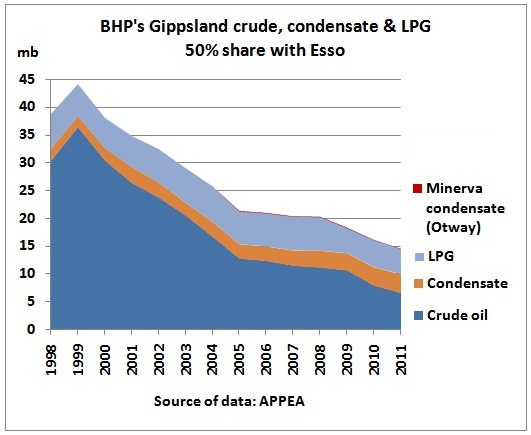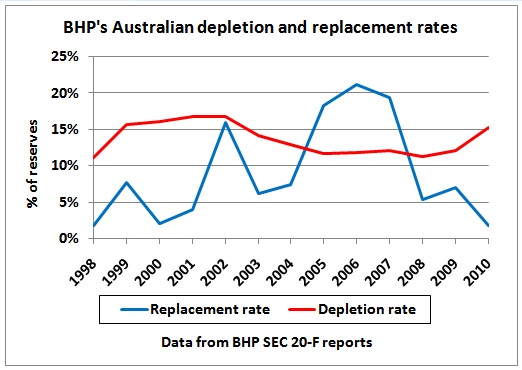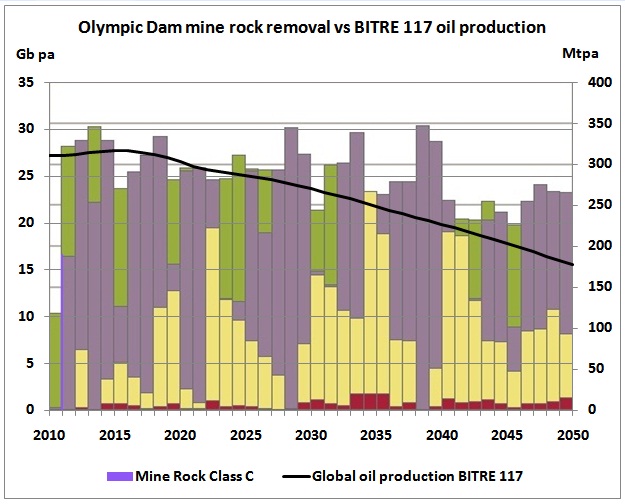BHP mothballs Olympic Dam expansion
BHP’s decision to change its strategy on its Olympic Dam expansion came as the company announced a 35 per cent slide in net profit
http://www.smh.com.au/business/mining-and-resources/bhp-mothballs-olympic-dam-expansion-20120822-24m4i.html
Mines need a lot of diesel. The Olympic Dam mine expansion would require 16 times more diesel than the current operation:
 http://www.olympicdameis.sa.gov.au/html/assessmentreport.cfm
http://www.olympicdameis.sa.gov.au/html/assessmentreport.cfm
How much is 429 ML (=2.7 mb) pa in comparison with BHP’s crude oil production in Gippsland, for example?
In BHP’s annual report 2011 we read on page 14:
“Together with our 50–50 joint venture partner, Esso Australia (a subsidiary of ExxonMobil), we have been producing oil and gas from Bass Strait, off the south-eastern coast of Australia, for over 40 years, having participated in the original discovery of hydrocarbons in 1965. We dispatch the majority of our Bass Strait crude oil and condensate production to refineries along the east coast of Australia”.
http://www.bhpbilliton.com/home/investors/reports/Documents/2011/BHPBillitonAnnualReport2011.pdf
 Data from: http://www.appea.com.au/oil-a-gas-in-australia/statistics.html
Data from: http://www.appea.com.au/oil-a-gas-in-australia/statistics.html
In Australian refineries, 1 barrel of crude produces around 0.32 barrel of diesel. So 2.7 mb of diesel would require 8.4 mb of crude. This is more than BHP’s 50% share of Gippsland’s entire Esso crude production of 13.1 mb in 2011. And the declining trend is clear from the graph. Note that according to the EIS, it would take 5 years to remove overburden for the mine.
So let’s have a look at BHP’s oil reserves
 Let’s put the Australian part of the operation into graphs using annual reports back to 1998:
Let’s put the Australian part of the operation into graphs using annual reports back to 1998:
 Oil reserve history of BHP Billiton for Australian liquids production. Data are from the forms 20-F for the Securities and Exchange Commission (SEC). BHP’s Australian oil reserves (crude oil, condensate, NGLs) are in long term decline. All data are from here:
Oil reserve history of BHP Billiton for Australian liquids production. Data are from the forms 20-F for the Securities and Exchange Commission (SEC). BHP’s Australian oil reserves (crude oil, condensate, NGLs) are in long term decline. All data are from here:
http://www.bhpbilliton.com/home/investors/reports/pages/default.aspx
 We see that except for 3 years (2008/10) production was higher than reserve additions (from improved recovery, revisions of earlier estimates, extensions and discoveries). In the last 3 years, only 38% of oil produced was replaced by reserve additions. There is a production uptick from offshore fields along the WA coast. However, the faster the oil is produced, the faster the fields will deplete.
We see that except for 3 years (2008/10) production was higher than reserve additions (from improved recovery, revisions of earlier estimates, extensions and discoveries). In the last 3 years, only 38% of oil produced was replaced by reserve additions. There is a production uptick from offshore fields along the WA coast. However, the faster the oil is produced, the faster the fields will deplete.
 Worse still, annual replacement rates have been declining for 4 years while annual depletion rates have been very high at a whopping 15%, meaning that reserves would be depleted in 7 years at 2010 production levels. Of course, this high production cannot be maintained but this number gives an idea about the problem.
Worse still, annual replacement rates have been declining for 4 years while annual depletion rates have been very high at a whopping 15%, meaning that reserves would be depleted in 7 years at 2010 production levels. Of course, this high production cannot be maintained but this number gives an idea about the problem.
 This graph shows the uptick of BHP Billiton’s WA crude oil production in relation to other operators who are in long term decline. Data from:
This graph shows the uptick of BHP Billiton’s WA crude oil production in relation to other operators who are in long term decline. Data from:
http://www.dmp.wa.gov.au/5592.aspx#5710
Conclusion:
Just like in the case of the Caltex refinery closure, the public is neither being informed about BHP Billiton’s declining oil production in Gippsland nor about their decline in Australian oil reserves. The mining sector will be hard hit by declining oil production, indirectly because the global economy cannot really grow if crude oil production does not grow and directly by high fuel prices.
Related posts:
27/7/2012
After Sydney’s refinery closure: Caltex to import fuel from Chevron’s shrinking sales
http://crudeoilpeak.info/after-sydney-refinery-closure-caltex-to-import-fuel-from-chevrons-shrinking-sales
25/6/2012
10 Mouse clicks to calculate Australian crude oil depletion of 83 %
http://crudeoilpeak.info/10-mouse-clicks-to-calculate-australian-crude-oil-depletion-of-83-per-cent
Addendum:
27/8/2012
 This is what BHP CEO Marius Kloppers said in his interview with Alan Kohler in Inside Business 26/8/2012:
This is what BHP CEO Marius Kloppers said in his interview with Alan Kohler in Inside Business 26/8/2012:
“The real driver here is that there have been general, industry wide cost increases which when coupled with high energy cost which is what we use a lot i.e. diesel, that just put the concept that we have been developing into a non-economic space. It’s really about project specifics and capital cost escalation that has caused us to defer this decision.
….Obviously that means we do need to kick back this project into what we call identification phase which is start engineering afresh. But the combination of high exchange rate, high cost and high energy costs at this particular point in time which we have got in Australia in this moment is a pretty unique set of circumstances. If you get any of these variables to change plus we can make some technological breakthroughs, we still think that this is a wonderful ore body that is going to be a very major copper mine in due course.”
http://www.abc.net.au/insidebusiness/content/2011/s3575530.htm
In my submission on the Olympic Dam mine expansion dated 6/8/2009 I warned the proponent about peak oil and the high diesel consumption for the project (table above). This is one of the graphs which I had included in the appendix  I also reminded the EIS evaluation team about
I also reminded the EIS evaluation team about
(1) Dr. Bakhtiari’s graph on Iranian oil export extinction (happening right now)
(2) Sadad-al-Husseini’s table showing 300 Gb of OPEC reserves being speculative resources
(3) The IEA’s decline rate analysis in its WEO 2008
(4) Peak oil 2000 in Australia
http://www.olympicdameis.sa.gov.au/html/publicsubmissionsK-O.cfm
So a lot of unnecessary work was done. The cost to companies of ignoring peak oil is huge and will increase as governments fail in their duty of care to advise the corporate sector (and the public) about future oil supplies.
We may note that the Draft Environmental Impact Statement (DEIS) was released by BHP publicly in May 2009, 2 months after BITRE completed its report 117, which calculated a global peak in oil production by the mid of the decade, just when rock removal was scheduled to be around 300 Mtpa.
 This graph shows the various types of mine rock which has to be removed to get at the ore body. A gigantic task. Let’s superimpose BITRE 117 oil production on the above graph:
This graph shows the various types of mine rock which has to be removed to get at the ore body. A gigantic task. Let’s superimpose BITRE 117 oil production on the above graph:
 Did the federal government not inform BHP about BITRE’s research in late 2008 or early 2009?
Did the federal government not inform BHP about BITRE’s research in late 2008 or early 2009?
Back to the interview, it gets worse:
Kloppers on coal: “We have a large slate of projects that are in our core products i.e. the products we like, they are well advanced, they are on budget and on schedule and they are in assets where we have operated for decades. All else being equal, the investments we have made on behalf of our shareholders in these products and in those mines are going to deliver volume increases over the next couple of years. We are targeting for example a 50% increase in our Queensland coal business in terms of capacity…”
http://www.abc.net.au/insidebusiness/content/2011/s3575530.htm
Well, decades of experience in coal mining will definitely NOT be of much use:
8/3/2010
NASA climatologist James Hansen at Sydney Uni: “Australia doesn’t agree now that they got to stop their coal, but they are going to agree. I can guarantee you that within a decade or so because the climate change will become so strongly apparent that’s going to become imperative”
20 seconds clip:
http://www.youtube.com/watch?v=qMD2sd0lPeg
Full lecture:
http://www.youtube.com/watch?v=5E5EdbiB4HU
From here:
http://www.usyd.edu.au/sydney_ideas/lectures/2010/professor_james_hansen.shtml
Mr. Kloppers, turn on your TV and look at all the fires, droughts, floods and storms all over the world. The Arctic summer sea ice is at record minimum so far this year. How does BHP think extreme weather events will be in a “couple of years”? To answer this question, the following document is a good start to read, published 2 weeks before the interview, research which can reasonably be expected to be known by top executives of companies whose “products” release a lot of CO2 when burnt:
Increasing Climate Extremes and the New Climate Dice
10 August 2012
James Hansen, Makiko Sato, and Reto Ruedy
Abstract. We address questions raised about our study “The New Climate Dice” by using longer base periods that include the 1930s. We show that the 2012 summer heat wave in the United States (June-July data) exceeds any that occurred in the 1930s. We reconfirm our conclusion that the increasing extremity of heat waves and the area covered by extreme events is caused by global warming. The location and timing of weather extremes depends on many factors and to a large degree is a matter of chance. Changing climate can be described, usefully and realistically, by the combination of “climate dice” and a shifting, broadening “bell curve”, an approach that we believe can be appreciated by the general public.
http://www.columbia.edu/~jeh1/mailings/2012/20120811_DiceDataDiscussion.pdf
So all things are not being equal in the years to come and these investments in coal mines will turn out not to be good for investors. Plus there will be – on a pro rata basis of cumulative emissions – future compensation claims from global warming damages. Who will pay these?